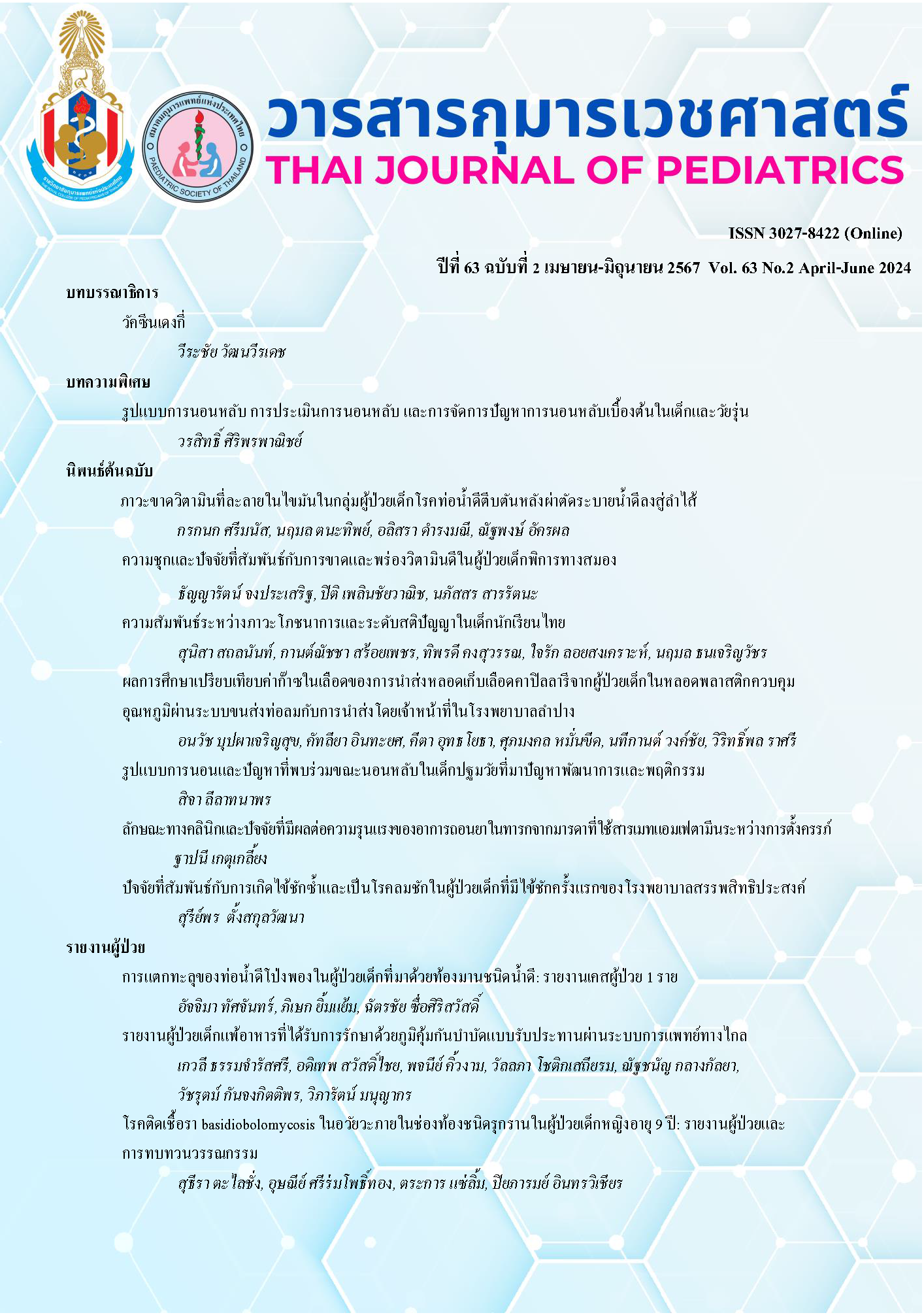ภาวะขาดวิตามินที่ละลายในไขมันในกลุ่มผู้ป่วยเด็กโรคท่อน้ำดีตีบตันหลังผ่าตัดระบายน้ำดีลงสู่ลำไส้
คำสำคัญ:
ท่อน้ำดีตีบตัน, พฤติกรรม, คะแนน Apgar, วิตามินที่ละลายในไขมัน , ขาดวิตามินบทคัดย่อ
ความเป็นมา: การขาดวิตามินที่ละลายในไขมันเป็นหนึ่งในภาวะแทรกซ้อนที่พบได้ในผู้ป่วยเด็กโรคท่อน้ำดีตีบตัน แม้ปัจจุบันจะมีแนวทางเสริมวิตามินและการให้โภชนบำบัดในผู้ป่วยกลุ่มนี้แล้ว แต่ก็พบว่าผู้ป่วยส่วนใหญ่ยังคงมีอาการและอาการแสดงของภาวะทุพโภชนาการและการขาดวิตามิน หากไม่ได้รับการรักษาที่เพียงพอภาวะนี้อาจเป็นอุปสรรคและส่งผลกระทบต่อผู้ป่วยรวมถึงผลลัพธ์ของการปลูกถ่ายตับในอนาคต
วัตถุประสงค์: เพื่อศึกษาความชุกของภาวะขาดวิตามินที่ละลายในไขมันในกลุ่มผู้ป่วยเด็กโรคท่อน้ำดีตีบตัน หลังผ่าตัดระบายน้ำดีลงสู่ลำไส้ และมีวัตถุประสงค์รองเพื่อหาปัจจัยเสี่ยงที่สัมพันธ์กับภาวะขาดวิตามินที่ละลายในไขมันในกลุ่มผู้ป่วยดังกล่าว
วิธีการศึกษา: ตรวจวัดระดับวิตามินที่ละลายในไขมันในผู้ป่วย โดยถือว่าผู้ป่วยมีการขาดวิตามินที่ละลายในไขมันเมื่อมีข้อใดข้อหนึ่งต่อไปนี้ 1) วิตามินเอน้อยกว่า 0.7 ไมโครโมล/ล. 2) ระดับ 25-OH D น้อยกว่า 20 นาโนกรัม/มล. 3) อัตราส่วนระหว่างวิตามินอีต่อคอเลสเตอรอลน้อยกว่า 2.22 ไมโครโมล/มิลลิโมล 4) ค่า INR มากกว่า 1.5 และสามารถแก้ไขได้ด้วยการให้วิตามินเค
ผลการศึกษา: ผู้ป่วยทั้งสิ้น 30 ราย เป็นชาย 13 ราย และหญิง 17 ราย อายุเฉลี่ย 7.9 ปี พบความชุกของการขาดวิตามินที่ละลายในไขมันอย่างน้อย 1 ชนิดถึงร้อยละ 36.7 (95% CI 18.4, 54.9) โดยมีภาวะขาดวิตามินเอร้อยละ 36.7 รองลงมาคือวิตามินดี วิตามินอี และวิตามินเคตามลำดับ จากการวิเคราะห์ข้อมูลแบบตัวแปรเดียว พบว่าการขาดวิตามินที่ละลายในไขมันในประชากรกลุ่มที่ศึกษามีความสัมพันธ์กับผู้ป่วยที่มีการผ่าตัด Kasai ที่ล้มเหลว ภาวะตับโต ผลตรวจทางห้องปฏิบัติการมีระดับ total bilirubin, direct bilirubin, PELD score และ inflammatory markers (ESR, CRP) สูง มีภาวะซีด โดยมีระดับ BUN และ Cr ในเลือดต่ำกว่ากลุ่มที่ไม่พบว่ามีภาวะขาดวิตามินที่ละลายในไขมัน
สรุป: การขาดวิตามินที่ละลายในไขมันในผู้ป่วยท่อน้ำดีตีบตันยังเป็นปัญหาที่พบได้บ่อย โดยพบการขาดวิตามินเอมากที่สุด ดังนั้น การติดตามระดับวิตามินอย่างใกล้ชิด จึงเป็นสิ่งสำคัญที่ช่วยป้องกันและปรับการรักษา โดยเฉพาะในผู้ป่วยที่มีค่า PELD score ที่สูง และมีแนวโน้มที่จะได้รับการรักษาโดยการผ่าตัดเปลี่ยนตับในอนาคต
Downloads
เอกสารอ้างอิง
Sanchez-Valle A, Kassira N, Varela VC, Radu SC, Paidas C, Kirby RS. Biliary Atresia: Epidemiology, genetics, clinical update, and public health perspective. Adv Pediatr. 2017;64:285-305.
Peng CH, Lee HC, Jiang CB, Hsu CK, Yeung CY, Chan WT, et al. Serum vitamin D level is inversely associated with liver fibrosis in post Kasai's portoenterostomy biliary atresia patients living with native liver. PLoS One. 2019;14:e0218896.
Tazawa Y, Nakagawa M, Yamada M, Konno T, Tada K, Ohi R, et al. Serum vitamin E levels in children with corrected biliary atresia. Am J Clin Nutr. 1984;40:246-50.
Yanofsky RA, Jackson VG, Lilly JR, Stellin G, Klingensmith WC, 3rd, Hathaway WE. The multiple coagulopathies of biliary atresia. Am J Hematol. 1984;16:171-80.
Ng J, Paul A, Wright N, Hadzic N, Davenport M. Vitamin D levels in infants with biliary atresia: Pre- and post-Kasai portoenterostomy. J Pediatr Gastroenterol Nutr. 2016;62:746-50.
Dong R, Sun S, Liu XZ, Shen Z, Chen G, Zheng S. Fat-soluble vitamin deficiency in pediatric patients with biliary atresia. Gastroenterol Res Pract. 2017;2017:7496860.
Shneider BL, Magee JC, Bezerra JA, Haber B, Karpen SJ, Raghunathan T, et al. Efficacy of fat-soluble vitamin supplementation in infants with biliary atresia. Pediatrics. 2012;130:e607-14.
Tamgal J, Damrongmanee A, Khorana J, Tepmalai K, Ukarapol N. Clearance of jaundice after the modified Kasai;s operation predicts survival outcomes in patients with biliary atresia. Turk J Pediatr. 2019;61:7-12.
McDiarmid SV, Anand R, Lindblad AS, Principal I, Institutions of the Studies of Pediatric Liver Transplantation Research G. Development of a pediatric end-stage liver disease score to predict poor outcome in children awaiting liver transplantation. Transplantation. 2002;74:173-81.
Rojroongwasinkul N, Kijboonchoo K, Wimonpeerapattana W, Purttiponthanee S, Yamborisut U, Boonpraderm A, et al. SEANUTS: The nutritional status and dietary intakes of 0.5-12-year-old Thai children. Br J Nutr. 2013;110:S36-44.
Saron ML, Godoy HT, Hessel G. Nutritional status of patients with biliary atresia and autoimmune hepatitis related to serum levels of vitamins A, D and E. Arq Gastroenterol. 2009;46:62-8.
Udomsinprasert W, Jittikoon J. Vitamin D and liver fibrosis: Molecular mechanisms and clinical studies. Biomed Pharmacother. 2019;109:1351-60.
Zhuang P, Sun S, Dong R, Chen G, Huang Y, Zheng S. Associations between vitamin D and liver function and liver fibrosis in patients with biliary atresia. Gastroenterol Res Pract. 2019:4621372.
Ko BJ, Kim YS, Kim SG, Park JH, Lee SH, Jeong SW, et al. Relationship between 25-hydroxyvitamin D levels and liver fibrosis as assessed by transient elastography in patients with chronic liver disease. Gut Liver. 2016;10:818-25.
Firrincieli D, Zuniga S, Rey C, Wendum D, Lasnier E, Rainteau D, et al. Vitamin D nuclear receptor deficiency promotes cholestatic liver injury by disruption of biliary epithelial cell junctions in mice. Hepatology. 2013;58:1401-12.
Kim HS, Rotundo L, Kothari N, Kim SH, Pyrsopoulos N. Vitamin D is associated with severity and mortality of non-alcoholic fatty liver disease: A US population-based study. J Clin Transl Hepatol. 2017;5:185-92.
Venkat VL, Shneider BL, Magee JC, Turmelle Y, Arnon R, Bezerra JA, et al. Total serum bilirubin predicts fat-soluble vitamin deficiency better than serum bile acids in infants with biliary atresia. J Pediatr Gastroenterol Nutr. 2014;59:702-7.
Silva AP, Pereira ADS, Simoes BFT, Omena J, Cople-Rodrigues CDS, de Castro IRR, et al. Association of vitamin A with anemia and serum hepcidin levels in children aged 6 to 59 mo. Nutrition. 2021;91-92:111463.
Gutowska K, Formanowicz D, Formanowicz P. Interrelations between iron and vitamin A-studied using systems approach. Int J Mol Sci. 2022;23:1189.
Bacchetta J, Zaritsky JJ, Sea JL, Chun RF, Lisse TS, Zavala K, et al. Suppression of iron-regulatory hepcidin by vitamin D. J Am Soc Nephrol. 2014;25:564-72.
ดาวน์โหลด
เผยแพร่แล้ว
รูปแบบการอ้างอิง
ฉบับ
ประเภทบทความ
สัญญาอนุญาต
ลิขสิทธิ์ (c) 2024 ราชวิทยาลัยกุมารแพทย์แห่งประเทศไทย และ สมาคมกุมารแพทย์แห่งประเทศไทย

อนุญาตภายใต้เงื่อนไข Creative Commons Attribution-NonCommercial-NoDerivatives 4.0 International License.



